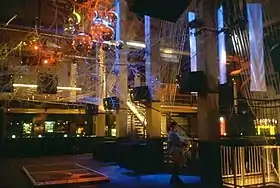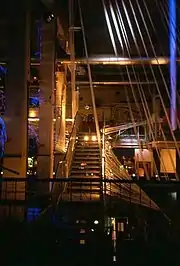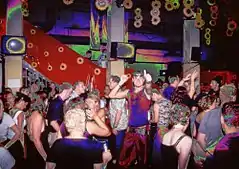KW – Das Heizkraftwerk
KW – Das Heizkraftwerk was a nightclub in Munich, Germany from 1996 to 2003.[1] The techno club belonged, besides the Tresor and E-Werk in Berlin, the Dorian Gray and Omen in Frankfurt, and the Munich-based clubs Ultraschall, Natraj Temple and Millennium, to the most renowned clubs of Germany's 1990s techno culture.[2]
 Main dancefloor of the KW | |

| |
| Address | Grafinger Str. 6, Kunstpark Ost |
|---|---|
| Location | Berg am Laim, Munich, Germany |
| Coordinates | 48°7′24″N 11°36′32″E |
| Type | Nightclub |
| Genre(s) | Techno, House |
| Construction | |
| Built | 1950s |
| Opened | 1996 |
| Closed | January 2003 |
| Website | |
| Official Website | |
History and description

The nightclub, which in everyday language often was just called KW or Kraftwerk (English: power plant),[3] opened in 1996 in a former combined heat and power plant on the grounds of the Kunstpark Ost, a former factory site of 90.000 m² close to the Ostbahnhof train station in Munich's Berg am Laim district.[4] It was the first large techno club on the grounds of the Kunstpark factory site.[5]
Reputation and star DJs
The club was renowned for featuring international stars of the techno, house and pop scene. The New Yorker David Morales was the premiere guest at the regular Saturday event called World League, which was held for the first time on 31 October 1996. Alongside Morales, international star DJs and live acts such as Sven Väth, Carl Cox, Paul van Dyk, Armand van Helden, Daft Punk, Masters at Work, Talla 2XLC, Marc Spoon, DJ Sneak, Frankie Knuckles, Bob Sinclar or Westbam performed regularly and often exclusively at the KW, when they were in Munich. Likewise, international pop stars such as Boy George or Jimmy Somerville of Bronski Beat chose the KW for their concerts.[4][6] Such events then frequently attracted thousands of visitors, many of them arriving from afar, to the Kunstpark Ost,[7] and soon the KW had built up a reputation all over Europe.[8]
Program and festivals
The musical program of the nightclub concentrated on techno and house music. The Friday event Powerplant laid the focus on techno. In contrast, the Saturday event called World League, which lives on as one of Munich's most famous event series in other clubs to this day, was dedicated to house music as well as guest appearances of international stars.[9] Among the residents of the KW were René Vaitl and DJ Tomcraft.[10][11] The door policy of the club was regarded as comparably tough.[12] Repeatedly the KW supplied lovemobiles to popular technoparades such as Berlin's Love Parade or Munich's Union Move. As well, the club was involved in major events of the techno scene such as Rave City.
Closing of the club
When the Kunstpark Ost party area had to close after the operator changed, the KW had to close as well on 31 January 2003. The reason given was that the club was too loud.[13] The last record at KW was played again by David Morales, who had already been the premiere guest.[14] While the regular club nights such as the World League continued at other locations and clubs in Munich,[4] the former power plant and techno club was re-used as an indoor adventure park for kids in a cooperation with Munich's Kindl foundation for kids in 2004.[15] It is planned that the old power plant, which still exists today, must make way for the projected central park of Munich's new Werksviertel district.[5]
Club architecture
The club was located in a decommissioned cogeneration power plant of the food manufacturer Pfanni, and poured on the charm of an old industrial production site.[16] Thus it represents an early example of the reutilization of disused power plants and their robust industrial setting as techno clubs, an approach that was later followed by clubs such as Berlin's Berghain (2004), the second Tresor (2007), and Munich's MMA Club (2014). The KW was subdivided into 3 levels: the main area with the main dancefloor, the upper level with the lounge area, and the basement. The hall-like main area was subdivided by several tall concrete columns and a large steel staircase, which led on to the upper level. The club housed several bars, and also had an outdoor chill-out area. Due to the geographical proximity to other popular clubs in Munich such as Ultraschall und Natraj Temple, the club had to deal with a phenomenon called club sharing.[8]
Gallery
In popular culture
In 2002, the music channel MTV2 Pop chose the KW as one of the "most trendy metropolitan clubs" as a setting for its live televised ODC 40 Club Tour in Germany.[17] In a special by German news magazine Der Spiegel on club culture from 1998, Sven Väth recommends the KW as one of the 5 most trendy clubs.[3] DJ Tomcraft, who was one of the residents at KW, reported that it was at KW where he tested his world-famous hit Loneliness (#1 UK Single Charts, #1 UK Dance Charts, #10 DE) on the crowd for the first time.[11] The nightclub was used as a filming location for the popular German ARD crime drama series Tatort (1970–present), doubling as the fictional nightclub K2 in the episode Totentanz ("dance of the dead") with Bela B.[18][19]
External links
| Wikimedia Commons has media related to KW – Das Heizkraftwerk. |
- Official website (archived from 2002)
See also
 Media related to KW – Das Heizkraftwerk at Wikimedia Commons
Media related to KW – Das Heizkraftwerk at Wikimedia Commons- List of electronic dance music venues
References
- Thillmann, Paulina (29 November 2017). "Deutschlandkarte: Legendäre Clubs" [Germany map: legendary clubs]. Zeitmagazin. Retrieved 20 June 2019.
- Hitzler, Ronald; Pfadenhauer, Michaela (1998). "A posttraditional society: Integration and distinction within the techno scene". In Frank Hillebrandt; Georg Kneer; Klaus Kraemer (eds.). Loss of safety? Lifestyles between multi-optionality and scarcity (in German). p. 85. doi:10.1007/978-3-322-83316-7. ISBN 978-3-531-13228-0.
- "Jung ist die Nacht: CLUB-TIPS" [Young is the night: club tips]. Spiegel Special. 1 August 1998. p. 6. Retrieved 20 June 2019.
(PDF version)
- Wulkow, Alex (3 November 2016). "Dancefloor-Dauerbrenner: 20 Jahre World League" [Continuous dancefloor burner: 20 years World League]. tz München. Retrieved 20 June 2019.
- Ick-Dietl, Carmen (18 November 2016). "Das Werksviertel wächst: Wir erklären, was wo entsteht" [The Werksviertel is growing: we explain where which things will arise]. Münchner Merkur. Retrieved 20 June 2019.
- "KW official guest dj's and live-acts list". Archived from the original on 11 February 2004. Retrieved 20 June 2019.
- "Corpus Techno: The Music of the future will soon be history". MUNICHfound. July 1997. Retrieved 20 June 2019.
- Söder, Francis (2006). "Hallenkultur und Event statt Denkmal und Industriekultur". In Thomas Kaestle; Manfred Walz; Ovis Wende (eds.). Kunst + Planung = Urbanität? Brachflächen zwischen Stadtentwicklung und urbaner Kunst [Hall culture and event instead of monument and industrial culture]. FH Dortmund. pp. 74–75.
- Spethling, Sabine (13 March 2018). "Munich Electronic Music Scene". tunes&wings. Retrieved 23 June 2020.
- Kröplin, Sofia (6 December 2019). "Faze Trip #München (Part 1) – Wo kommt eigentlich der Münchner Techno her?" [Faze Trip #Munich (Part 1) – Where does Munich Techno actually come from?]. Faze Magazin. Retrieved 22 December 2019.
- "Feature: Tomcraft". dmcworld magazine. Retrieved 20 June 2019.
- "Kraftwerk on München-Party.de". Retrieved 20 June 2019.
- Temsch, Jochen (17 May 2010). "Der neue Kunstpark Ost: Ein sauberer Spaß" [The new Kunstpark Ost: a clean pleasure]. Süddeutsche Zeitung. Retrieved 20 June 2019.
- "Letzte Platte im KW" [The last record at KW]. Technoforum. 27 January 2003. Retrieved 20 June 2019.
- "Neues in Kultfabrik: Kult-Kids" [News in the Kultfabrik: Kulti-Kids]. Münchner Wochenanzeiger. 11 February 2004. Retrieved 20 June 2019.
- Baum, Martina (2008). Urbane Orte Teil II [Urban Places Part II] (PDF) (in German). Karlsruhe: Universitätsverlag Karlsruhe. ISBN 978-3-86644-286-3. Retrieved 20 June 2019.
- "New Yorker geht mit MTVPop auf Deutschlandtour" [New Yorker goes on Germany tour with MTVPop]. New Business Verlag. Archived from the original on 17 February 2017. Retrieved 20 June 2019.
- Winkler-Schlang, Renate (30 July 2019). "Berg am Laim: Dampf ablassen in der Energiezentrale" [Letting off steam at the energy plant]. Süddeutsche Zeitung. Retrieved 17 October 2019.
- "Tatort: Totentanz" [Crime scene: dance of the dead]. Das Erste. Retrieved 17 October 2019.






